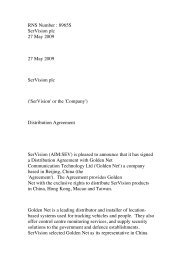TVG-Series System Guide v1-4 - SerVision
TVG-Series System Guide v1-4 - SerVision
TVG-Series System Guide v1-4 - SerVision
Create successful ePaper yourself
Turn your PDF publications into a flip-book with our unique Google optimized e-Paper software.
<strong>SerVision</strong><br />
<strong>TVG</strong> <strong>System</strong> <strong>Guide</strong><br />
Figure 20: Microphone v olume settings (HV G, MV G, UV G)<br />
Figure 21: Microphone v olume settings (CV G, CV G-M)<br />
3. Click Update Now (see figure 19 on page 25). The volume settings are updated on the <strong>TVG</strong> immediately.<br />
Note: All of the settings on the page are saved when you click Update Now. The volume settings are<br />
implemented immediately, and the changes to the other settings are implemented after the unit is restarted (see<br />
Saving Configuration Changes, page 125). If you modify the volume settings and click the Update button in<br />
the lower-right corner of the screen, the volume settings are not implemented until the unit is restarted.<br />
4. In the client application, listen to the audio from the video stream that is linked to the microphone.<br />
5. Repeat steps 2–4 as necessary until the optimal volume setting is selected.<br />
Configuring GPS<br />
When GPS is enabled on an MVG or CVG-M unit, the unit uses the built-in GPS receiver to check its location at<br />
specified intervals. Whenever you are connected to the unit through the MultiClient, the location data that is<br />
received is automatically sent to the MultiClient. You can then use the MultiClient to view the last detected location<br />
of the unit on a map.<br />
If you choose to record GPS data, you can use the MultiClient to see the path that was taken by the unit before it<br />
reached its last detected location. Recorded data is stored on the unit until the allocated disk space is filled; then, the<br />
oldest data is overwritten by the new data. The unit can store over one million GPS data points – approximately 2<br />
months’ worth of location data when the data is retrieved every 5 seconds.<br />
If you have a server that can receive GPS data, MVG and CVG-M units can be configured to send the data to that<br />
server at specified intervals. Alternatively, you can send the data to a device connected to the serial port (the<br />
RS232/485 connector) of the <strong>TVG</strong> unit. (For additional information about this option, please consult your<br />
vendor.)<br />
GPS data can be sent in one of two syntaxes. These syntaxes are part of the NMEA (National Marine Electronics<br />
Association) standard that defines the data required to process a GPS location. The available syntaxes are:<br />
• SV-RMC: A modified version of Recommended Minimum sentence version C that includes some additional<br />
information that is not included in the standard NMEA definition, such as the name of the sending unit. Please<br />
consult your vendor for a complete description of this sentence.<br />
• GGA sentences: Standard GGA sentences<br />
Once the GPS data is received by your NMEA server or a device connected to the serial port, you can use it as you<br />
wish – to display in a map, monitor vehicle locations and possible deviations from the intended route, or store the<br />
data for future use.<br />
NOTE:<br />
<strong>SerVision</strong> does not provide any software for handling NMEA data that is transmitted to an NMEA<br />
server. You must acquire and set up any required software on your own.<br />
Configuring <strong>System</strong> Settings 26





